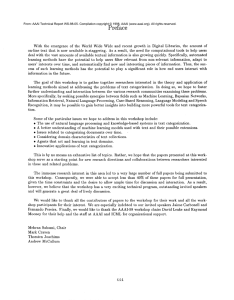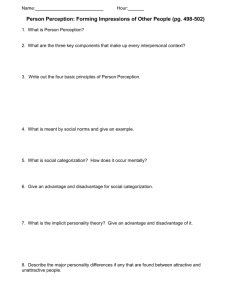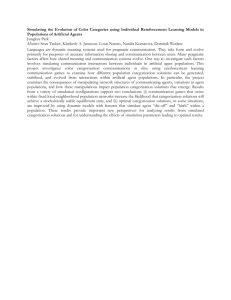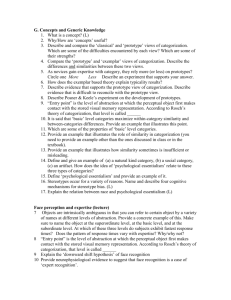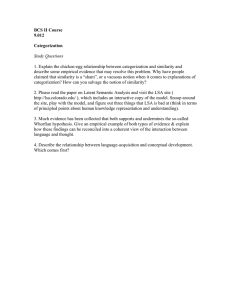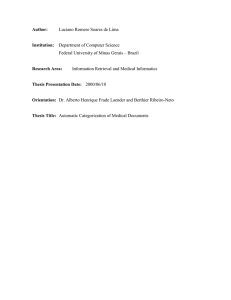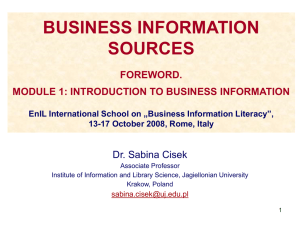Style-based Text Categorization: What Newspaper Am I Reading?
advertisement
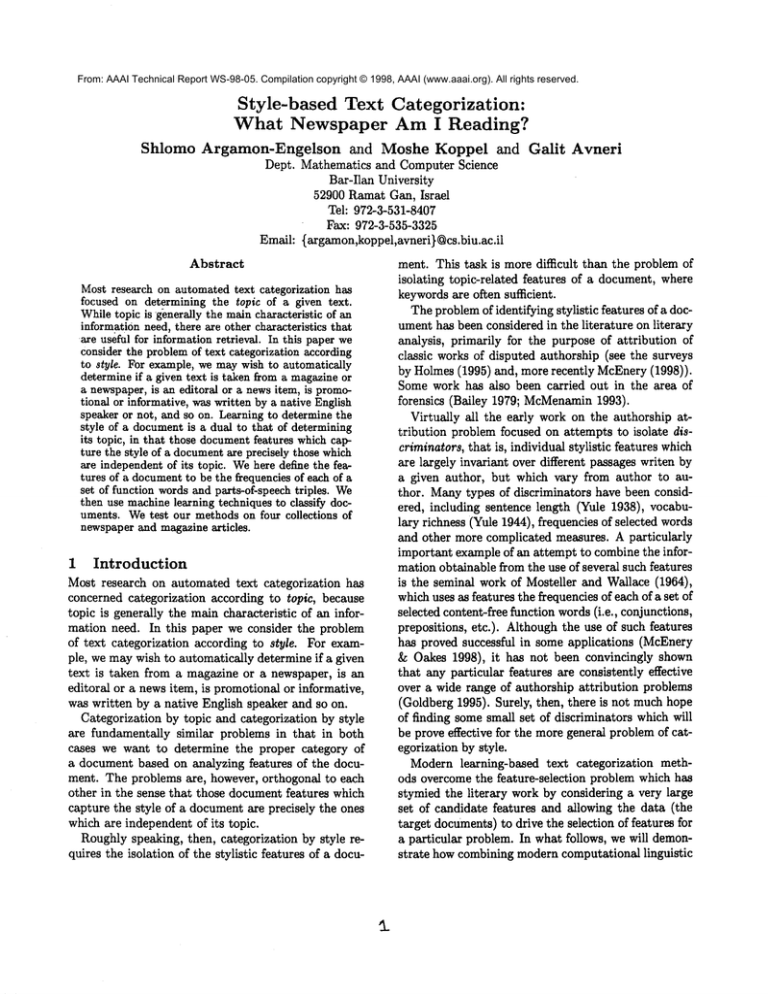
From: AAAI Technical Report WS-98-05. Compilation copyright © 1998, AAAI (www.aaai.org). All rights reserved.
Style-based
Text Categorization:
What Newspaper
Am I Reading?
Shlomo Argamon-Engelson and Moshe Koppel and Galit Avneri
Dept. Mathematics and Computer Science
Bar-Ilan University
52900 Ramat Gan, Israel
Tel: 972-3-531-8407
Fax: 972-3-535-3325
Emaih {argamon,koppel,avneri) @cs.biu.ac.il
Abstract
ment. This task is more difficult than the problem of
isolating topic-related features of a document, where
keywordsare often sufficient.
The problemof identifying stylistic features of a document has been considered in the literature on literary
analysis, primarily for the purpose of attribution of
classic works of disputed authorship (see the surveys
by Holmes(1995) and, more recently McEnery(1998)).
Some work has also been carried out in the area of
forensics (Bailey 1979; McMenamin
1993).
Virtually all the early work on the authorship attribution problem focused on attempts to isolate discriminators, that is, individual stylistic features which
are largely invariant over different passages writen by
a given author, but which vary from author to author. Manytypes of discriminators have been considered, including sentence length (Yule 1938), vocabulary richness (Yule 1944), frequencies of selected words
and other more complicated measures. A particularly
important example of an attempt to combine the information obtainable from the use of several such features
is the seminal work of Mosteller and Wallace (1964),
whichuses as features the frequencies of each of a set of
selected content-free function words(i.e., conjunctions,
prepositions, etc.). Although the use of such features
has proved successful in some applications (McEnery
& Oakes 1998), it has not been convincingly shown
that any particular features are consistently effective
over a wide range of authorship attribution problems
(Goldberg 1995). Surely, then, there is not muchhope
of finding some small set of discriminators which will
be prove effective for the more general problem of categorization by style.
Modern learning-based text categorization
methods overcome the feature-selection
problem which has
stymied the literary work by considering a very large
set of candidate features and allowing the data (the
target documents) to drive the selection of features for
a particular problem. In what follows, we will demonstrate how combining modern computational linguistic
Most research on automated text categorization has
focused on determining the topic of a given text.
Whiletopic is generally the maincharacteristic of an
information need, there are other characteristics that
are useful for information retrieval. In this paper we
consider the problemof text categorization according
to style. For example, we maywish to automatically
determine if a given text is taken from a magazineor
a newspaper,is an editoral or a newsitem, is promotional or informative, was written by a native English
speaker or not, and so on. Learning to determine the
style of a documentis a dual to that of determining
its topic, in that those documentfeatures whichcapture the style of a documentare precisely those which
are independentof its topic. Wehere define the features of a documentto be the frequencies of each of a
set of function words and parts-of-speech triples. We
then use machinelearning techniques to classify documents. Wetest our methods on four collections of
newspaperand magazinearticles.
1
Introduction
Most research on automated text categorization has
concerned categorization according to topic, because
topic is generally the main characteristic of an information need. In this paper we consider the problem
of text categorization according to style. For example, we may wish to automatically determine if a given
text is taken from a magazine or a newspaper, is an
editoral or a news item, is promotional or informative,
was written by a native English speaker and so on.
Categorization by topic and categorization by style
are fundamentally similar problems in that in both
cases we want to determine the proper category of
a document based on analyzing features of the document. The problems are, however, orthogonal to each
other in the sense that those document features which
capture the style of a document are precisely the ones
which are independent of its topic.
Roughly speaking, then, categorization by style requires the isolation of the stylistic features of a docu-
T
Vechnology with machine learning techniques can be
used to advantage for style-based categorization.
2 The
2.1
and 75 percent of the documents our document collection.
It should be noted that we exclude from consideration any content-bearing features even though these often prove useful. For example, in determining whether
a particular
passagewas writtenby ArthurConan
Doyle,it wouldbe perfectly
reasonable
to checkthe
frequency
of appearance
of, say,"Sherlock".
Nevertheless,
in thelarger
picture
suchfeatures
canbe deceptive.
For example,
givena setof New YorkTimes
documents
abouttheMiddleEastand a set of Daily
Newsarticles
aboutPresident
Clinton,
we wouldwant
to correctly
categorize
a Timesarticle
aboutClinton
as beingfromtheTimesandnotthe DailyNews.
Algorithm
Characterizing
Textual
Style
The first step is to characterize a given document in
terms of somevery large class of stylistic features. In
this paper we consider two types of features: lexical
and pseudo-syntactic.
The lexical features are simply the frequency of function words, such as and, about, and the. Function
words have been a staple of authorship attribution research since the work of Mosteller and Wallace (1964).
The rationale behind their use is that the frequency
of such words is presumably not driven by content and
hence might be expected to remain invariant for a given
author over different topics. By the same reasoning, we
might expect such invariance within classes of similar
documents. For example, the word you might appear
frequently in promotional literature, the word should
might appear frequently in editorials, and the word today might appear frequently in news items. In this
work, we use a list of 500 function words, considerable
more than previous studies have used (most used fewer
than 20).
In addition to function words, we use a different
set of features which more directly encode information
about the syntactic structure of the text. Syntactic
structure can be expected to be more revealing than
simple words counts, as has been argued in the work
of Baayen et al. (1996). The idea is that particular
documentclasses will favor certain syntactic constructions. Previous work on syntactic features (Baayen,
van Halteren, & Tweedie 1996) was based upon automated parsing of the input texts. However, as has
been pointed out by McEnery(1998), this is a timeconsuming and unreliable procedure; what is required
is a method of capturing underlying syntactic structures in an efficient and reliable fashion.
In this paper we adopt the following simple and robust approach: Wefirst tag each word in the text by
its part-of-speech (POS), using Brill’s rule-based partof-speech tagger (Brill 1992) (which uses the tagset
from the Browncorpus). The features we consider then
are POS trigrams. Trigrams are large enough to encode useful syntactic information, while small enough
to be computationally managable. For example, very
frequent use of the trigram personal-pronoun; present
tense-verb; verb-gerund might be indicative of a particular, possibly Germanic, syntactic style. While there
are over 100,000 possible trigrams, we only consider
as features those trigrams which appear in between 25
2.2
Learning
Once a feature set has been chosen, a given text passage can be represented by an n-dimensional vector,
where n is the total number of features. Given a set
of pre-categorized vectors, we can apply any machine
learning algorithm to try to determine the category of a
given new document. In our experiments, we used Ripper (Cohen 1995), a memberof the family of decisiontree learning algorithms, which has been used successfully on topic-based text classification problems (Cohen & Singer 1996). Since Ripper’s bias towards small
conjunctive rules is not appropriate for every text categorization problem, other learning algorithms might
also be considered. One interesting alternative to Ripper might be an algorithm such as Winnow(Littlestone
1988) which learns linear separators.
3
3.1
Experiments
Methodology
Wetested our method using four text collections1:
NY Times news 200 national (U.S.)
from the month of January 1998
news stories
NYTimes editorial 200 editorial and op-ed articles
from the month of January 1998
NY Daily News 200 mostly 2 national
from the month of January 1998
news stories
Newsweek200 magazine articles on domestic U.S. issues from July 1997 through the end of January 1998
~This data was obtained from the Nexusdatabase.
2Nexusdoes not allow selecting only national stories
from the Daily News.Wechose articles from the first seven
pages of the paper whichare the pages usually reserved for
national news.
7_
Comparison
Times news vs. editorial
Times news vs. Dally News
Times news vs. Newsweek
Times editorial vs. Newsweek
Daily Newsvs. Times editorial
Dally News vs. Newsweek
FW POS Both
78
69.3 79.5
82.3 63.1 84.3
80.5 79.3 83.8
61.3 7O
68.5
77.6 67.3 78.1
78.5 79.6 80.6
Let us consider someof the signature features which
turn up. The word today is a signature feature of Times
news stories, while the word yesterday is a signature
feature of Dally Newsstories. Over 70%of Times stories and Dally News stories contain the words today
and yesterday, respectively, while the reverse holds for
less than 20%of the stories.
Similarly, there are some interesting signature features among the POS triples. A signature triple for
Newsweekmagazine is end-quote; present-tense-verb;
proper-nounas in ’... yada, yada, " opines Costanza’.
This triple appears in only 1.3% of the newspaper articles, whereas it appears in 32%of Newsweek
articles.
This indicates that Newsweekoften uses present tense
verbs where newspapers would use a past tense verb.
A signature triple for Times news is determiner;
proper-noun; pausal-punctuation as in: ’ButMr.Gore
has used previously scheduled stops -- like his
appearances with the President on Wednesday in
the Midwest- to lend his energetic support.’ This
reflects the fact that the Timesuses more complexsentence structure.
The results in the above table simply reflect the
pervasiveness of the various signature features. The
news stories (in both newspapers) are most easily distinguished from other sources and from each other by
their respective use of certain words, while Newsweek
is most easily distinguished from the others by its distinctive syntax.
One immediate conclusion from this is that in each
classification task considered here it is not difficult to
isolate features that work very reliably for someclasses
of documents wheras for other classes these methods
are inconclusive.
Table 1: Results of 5-fold validation experiments for
different data sets and feature sets.
All the documents contained between 300 and 1300
words. During the chosen periods, the number of available documents in each category was slightly above
200, so the first 200 were chosen. Since the newspaper articles covered the same dates, they also covered
roughly the same topics (lots of Clinton-Lewinsky).
The collections were tested for palrwise distinguishability. In each experiment, two collections were selected. The 400 documents were transformed into feature vectors and divided into training and test sets
using five-fold cross validation. Each of these experiments was run using three different feature sets:
FWThe frequencies of each of 500 function words,
POS The frequencies
and
of each of 685 POS trigrams,
Both Both the function word and trigrams frequencies together.
3.2 Results
Table 1 summarizes the accuracy results of five-fold
cross validation for each of the six pairwise experiments
and each feature set.
A careful review of the rules produced by Ripper
adds insight into the meaning of these results. Consider for examplethe following rules for distinguishing
Times news stories from Dally Newsstories using only
function words.
4
NYT_NEWS:- today>=2,yesterday<=2(104/5).
NYT_NEWS:- that>=25,her<=10,will<=3(30/10).
defaultDAILY_NEWS(148/9-4).
The numbers
in parentheses
aftereachrulereflect
thenumberof documents
(correctly/incorrectly)
clasifledby thatrule.Theerrorrateon the80 testdocumentsis 15%.
Thepicture
thatemerges
isthatthere
areoftena relatively
smallnumberof signature
features
whichvery
decisively
marka document
as belonging
to a particularcollection.
Difficulties
arisewhena document
does
nothaveanyof thesignature
features.
3
Discussion
In this paper we have introduced the problem of stylebased text categorization. This problem subsumes the
problem of authorship attribution and goes well beyond it to a broad range of applications in information
retrieval.
This is definitely work in progress; muchmore experimentation is required. Learning algorithms other than
Ripper might be considered, especially those which
have already been successfully used on content-based
text categorization problems, such as Winnow(Dagan,
Karov, & Roth 1997; Lewis et al. 1996) and Naive
Bayes (Lang 1995). Also classes of features other than
function words and POS trigrams might be tried. Finally, and perhaps most importantly, these methods
must be tested on a muchwider variety of style-based
categorization problems.
References
Baayen, H.; van Halteren, H.; and Tweedie, F. 1996.
Outside the cave of shadows: Using syntactic annotation to enhance authorship attribution. Literary and
Linguistic Computing 11.
Bailey, R. 1979. Authorship attribution in a forensic
setting. In Aeger, D.; Knowles, F.; and Smith, J.,
eds., Advances in Computer-Aided Literary and Linguistic Research.
Brill, E. 1992. A simple rule-based part of speech tagger. In Proc. of ACLConference on Applied Natural
Language Processing.
Cohen, W., and Singer, Y. 1996. Context-sensitive
methods for text categorization. In Proceedings of
SIGIR.
Cohen, W. 1995. Fast effective rule induction. In
Proceedings of the Twelfth International Conference
on Machine Learning.
Dagan, I.; Karov, Y.; and Roth, D. 1997. Mistakedriven learning in text categorization. In Proceedings
of Second Conference on Empirical Methods in Natural Language Processing (EMNLP-2).
Goldberg, J. 1995. Cdm: An approach to learning
in text recognition. In Proceedings of the 7th IEEE
International Conference on Tools with Artificial Intelligence.
Holmes, D. 1995. Authorship attribution.
and the Humanities 28.
Computers
Lang, K. 1995. Newsweeder: learning to filter net
news. In Proceedings of the Twelfth International
Conference on Machine Learning.
Lewis, D.; Schapire, R. E.; Callan, J. P.; and Papka,
R. 1996. Training algorithms for linear text classifiers.
In SIGIR ’96: Proc. of the 19th Int. Conference on
Research and Development in Information Retrieval,
1996.
Littlestone, N. 1988. Learning quickly when irrelevant
features abound: A new linear-threshold
algorithm.
Machine Learning 2.
McEnery, A. M., and Oakes, M. P. 1998. Authorship studies/textual statistics. In Dale, R.; Moisl, H.;
and Somers, H., eds., Handbook of Natural Language
Processing. forthcoming.
McMenamin,G. 1993. Forensic Stylistics.
Elsevier.
Mosteller,
F., and Wallace, D.L. 1964. Applied
Bayesian and Classical Inference: The Case of the
Federalist Papers. Springer.
Yule, G. 1938. On sentence length as a statistical
characteristic of style in prose. Biometrika 30.
Yule, G. 1944. The Statistical Study of Literary Vocabulary. Cambridge University Press.
